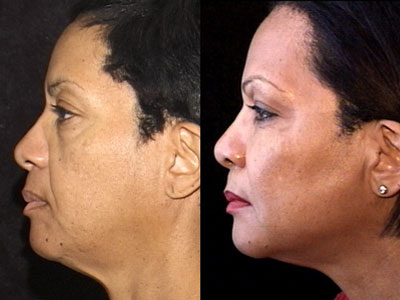Space Lift
(Fat Grafting)
Space Lift Video
See Dr. Berman's latest advance in face lift called the "Space Lift"
Facial aging is essentially caused by two things - loss of fat and skin elasticity. That's right. It's that simple. Gravity does not cause aging, it only affects how we look in different positions. As we age, the skin envelope gets closer to the skeleton and the fat, that fills the face, dissipates. When the skin is elastic, the person may look "skeletal" as the skin is tight around the face. With progressive age and loss of elasticity, the skin sags. In order to restore natural, youthful appearances, it's important to restore the skin in a three dimensional way, lifting it away from the skeleton. Face lift procedures lift the skin up and pull it back, and, ultimately pull the skin closer toward the skeleton. With an aging face you really need to lift the skin away from the skeleton. That's why people with face lifts don't always look that good. They may look better than they did, but they don't look naturally youthful again. The face is three dimensional and the most important dimension (the anterior position of the skin, i.e. away from the skeleton) needs to be properly addressed. By harvesting fat from another part of your body, it can then artistically be grafted back into your face to restore the natural, youthful contours. I coined the term "Space Lift" to describe the concept of lifting the skin away from the skeleton by fat grafting techniques.

Fat grafting techniques have come a long way since I started performing it in the late eighties. Currently, I'm using the Lipokit system developed in Korea. This is the latest technology that has allowed us to maximize the outcome of fat grafting. It uses a syringe harvest technique that removes all impurities from the harvested fat in a completely closed system. This provides an 80 - 90% survival of the transplanted fat grafts. Also, this fat is richly bathed in pre-adipocytes also known as stem-cells. This may partly explain why patients tend to notice improvement in their skin quality as well as improvements in their facial contours.
The first signs of aging are usually seen as subtle changes around the eyes. Fat grafting should be considered as the first treatment for the aging eyelids and traditional, cutting (skin excision) blepharoplasty should be reserved for the rare cases where filling is just not enough. This usually is seen with older (over 70) individuals or patients that always felt their lids were too "heavy" and want a different shape. Most patients that present for "rejuvenation" procedures don't want to look different, but rather, want to look like they used to. We suggest patients bring their favorite photos of themselves when they come for their consultation. Often, we can superimpose their current appearance over their old photo and they can see how the their facial appearance has changed.
When "Space Lifting" (facial fat grafting) alone is not enough (there's too much sagging skin), then lifting procedures can be added. Today, lifting is done by doing a "short incision face lift." This incision does not disturb the hairline and results in a very small scar around the natural curves of the ear, occasionally extending slightly behind the ear. Toady, many doctors are advertising this minimal incision face lift under a variety of names. Dr. Ziya Saylan should be credited for re-popularizing the short incision lift - he coined it as the "S Lift." By adding fat grafting to the procedure we have a real 3D (three dimensional) face lift. Risks of traditional lifting are significantly diminished as well. These procedures are done on an out-patient basis under local anesthesia with intravenous sedation.
Fat grafting helps to naturally set back the clock. It replaces lost fat. As such, it's not truly permanent, but replenishes natural fat stores until they are metabolized and noticeably reduced again. Some doctors prefer permanent implant materials because they want a permanent result. However, because we always metabolize and lose our facial fat, there is no permanent result and eventually, fat will be needed (or some other filler) to correct natural losses that periodically become noticeable.
While fat grafting is probably the most artistically demanding of all surgical procedures, it gives the patients the opportunity to naturally restore their youthful appearance without looking "surgical" or even showing the signs of surgery.